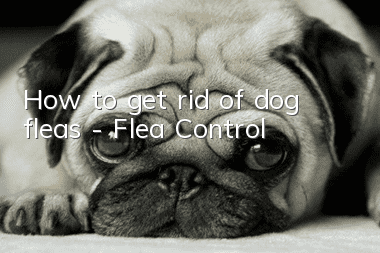How to get rid of dog fleas - Flea Control

Measures to eliminate fleas in dogs
1. Use anthelmintics. There are many anthelmintics available on the market, such as Da Chong Ai, Fulien, etc.2. Thoroughly disinfect the floors and walls of the kennel, especially the dog’s utensils, so that there is no hiding space for fleas.
3. Paying attention to dog body hygiene, bathing frequently, grooming frequently, and spending more time in the sun are effective ways to prevent fleas.
4. It is also a good idea to buy an anti-flea collar. This kind of collar contains flea-killing medicine, which can repel or kill fleas when encountering them. But be aware that long-term use in some dogs can cause skin allergies.
5. Dogs with skin abrasions should be debrided, disinfected and prevented from infection.
Causes of flea parasitism in dogs
1. Fleas are generally called fleas. Dog fleas, cat fleas, cock fleas, etc. can be seen on dogs. The flea body is 1-3 mm long, dark brown or yellowish brown. The body surface has a thick chitinous skin and piercing and sucking mouthparts. The head is small and closely connected with the chest. The antennae are short and thick, divided into 3 sections, lying flat in the antennal groove.2. Fleas do not live on dogs for most of their lives. Because fleas are afraid of light, they often hide in the bedding of the kennel or in the cracks of the floor. They only infect the dog when they suck blood and lay eggs.
3. The eggs hatch into larvae. The larvae are cylindrical, legless, chewing mouthparts, 4 to 5 mm in length, and feed on dust, dirt or hemoglobin-containing feces of adult dogs.
4. When mature, the larvae spin the loose cocoon to attach to food debris and pupate. After about 5 days under optimal conditions, the adult worm escapes from the cocoon and looks for a host to feed and continue its developmental history.
5. Because fleas are highly mobile and have a wide range of host selectivity, they have become important spreaders of certain diseases.
Symptoms of fleas in dogs
1. The clinical symptoms of this disease are mainly itching. The symptoms of sick dogs are scratching, rubbing and biting the coat, causing hair loss, hair breakage and abrasions. In severe cases, fluid may leak out from the skin abrasions, and even suppurative wounds may form.2. Sometimes it can cause allergic reactions and form eczema.
3. If the dog is found to have the above symptoms, carefully examine the dog and find fleas or flea debris between the coat. Fleas tend to be most abundant near the head, buttocks, and tail tip. During the examination, comb the coat against the direction of hair growth and observe the hair roots and skin. If fleas or flea droppings are found, the diagnosis can be confirmed.
4. You can also use a piece of moist white paper, place it under the dog, and then comb the hair with a comb. The flea excrement will continue to fall on the white paper, and the diagnosis can be confirmed.
Random articles
- What do dogs eat to protect their stomach? It is important to protect their stomach and treat gastrointestinal diseases in dogs.
- How to tell if your dog is fat? Is your dog overweight?
- Will your dog catch a cold if you blow the air conditioner? What should you do if your dog catches a cold if you blow the air conditioner?
- What should you pay attention to when your dog drinks water? Don’t be careless when it comes to your dog’s drinking water.
- The dog's mouth bites and shakes. Why does the dog's mouth occasionally shake and bite?
- How to cut a dog's hair? Do you know how to cut a dog's hair correctly?
- Can dogs eat raw eggs? Why can’t dogs eat egg whites?
- Common Dog Problems in Summer How to Deal with Different Dog Problems
- How to keep dogs away from skin diseases. If you do this, will you see if your dog will still be infected with skin diseases?
- What causes anorexia in dogs? Dogs will become anorexic due to lack of exercise. Hounds run at least 5KM every day.



